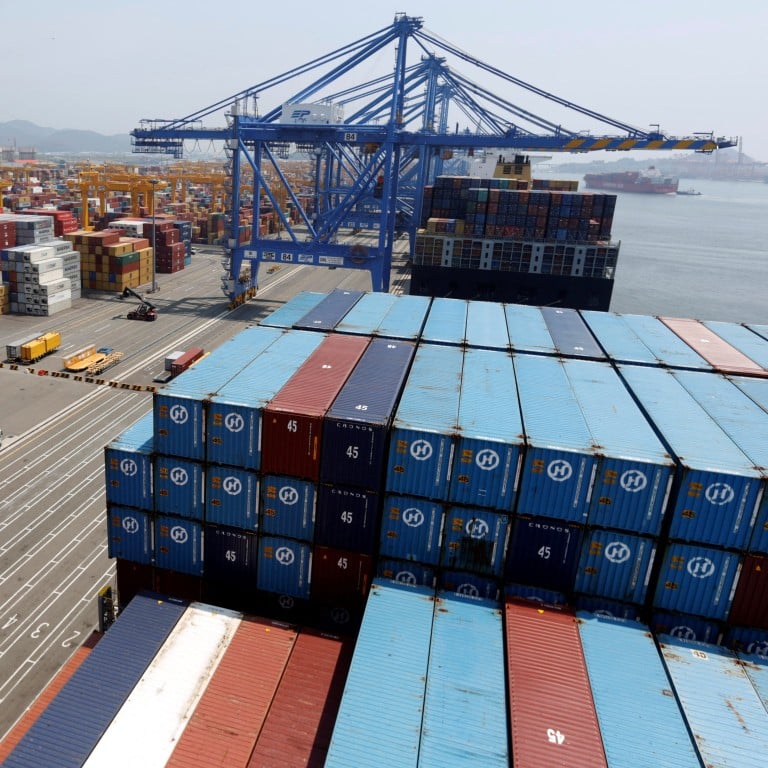
South Korea’s US$60 billion swing in China trade due to ‘shrinking tech advantage’ as deficit emerges
- South Korea recorded a trade deficit of US$5.1 billion with China in January and February, which was the highest among all its trading partners
- South Korea’s trade deficit with China is not a temporary phenomenon, but a structural problem as the comparative advantage of its products is disappearing, an analyst said
In just five years South Korea has gone from selling over US$55 billion more to China than it imported to recording a trade deficit of over US$5 billion at the start of 2023, with an analyst pointing to its shrinking “technological comparative advantage”.
South Korea recorded a trade deficit – meaning it imports more than it exports – of US$5.1 billion with China in January and February, which was the highest among all its trading partners, the Korea International Trade Association said on Tuesday.
This was a larger trade deficit than South Korea had with Australia – its largest coal exporter – at US$4.8 billion and Saudi Arabia – its largest crude oil exporter – at US$4.6 billion.
In contrast, the United States contributed the largest trade surplus of US$4.1 billion in the first two months of the year.
As [South Korea’s] technological comparative advantage shrinks, the deficit with China will widen. Therefore, it is very urgent to make efforts to keep the technology gap
“As [South Korea’s] technological comparative advantage shrinks, the deficit with China will widen. Therefore, it is very urgent to make efforts to keep the technology gap,” said Park Ki-soon, a senior adviser for Dentons Lee law firm.
He said that South Korea’s trade deficit with China is not a temporary phenomenon caused by the price rise of raw materials, but rather a structural problem as the comparative advantage of its products is disappearing.
Chemical raw materials, batteries and storage batteries, computers and industrial electrical equipment were the South Korean products that had the largest trade deficit with China in combined figures for January and February.
South Korea enjoyed a US$55.6 billion trade surplus with China in 2018, with the last annual trade deficit US$1.1 billion in 1992 when Beijing and Seoul established diplomatic relations.
China’s Shandong province and South Korea move to revive economic ties
“An example of this is the decrease in the number of surplus items and the increase in the number of deficit items in trade between Korea and China,” added Park.
South Korean businesses, Park said, must start to properly target the Chinese market and adapt to meeting the needs and preferences of consumers.
“Last year, China’s trade ranked second among the world’s five major trade powers, while its import growth rate ranked second. The trade structure is gradually transforming into a self-reliant and domestic-oriented model,” said Korea International Trade Association official Jang Sang-sik, according to the Yonhap News Agency.
“In particular, intermediate goods and consumer goods led the increase in exports, and the export structure is gradually becoming similar to Korea, which is also centred on intermediate goods.”
In the first 20 days of March, South Korea’s exports to China also plunged by 36.2 per cent from a year earlier, while imports increased by 9.1 per cent, the Korea Customs Service said last week.
The slump was largest in the shipments of semiconductors – South Korea’s major export product – which dropped by 44.7 per cent in the first 20 days of March.
The US was South Korea’s only major trading partner to record a growth in exports at the start of March as shipments increased by 4.6 per cent, year on year.
China’s stake in South Korea’s overall foreign trade also dropped below 20 per cent for the first time at the start of the year after it had reached a record high of 26.8 per cent in 2018.
Between January 1 and March 20, China accounted for just 19.8 per cent of South Korea’s total exports.


